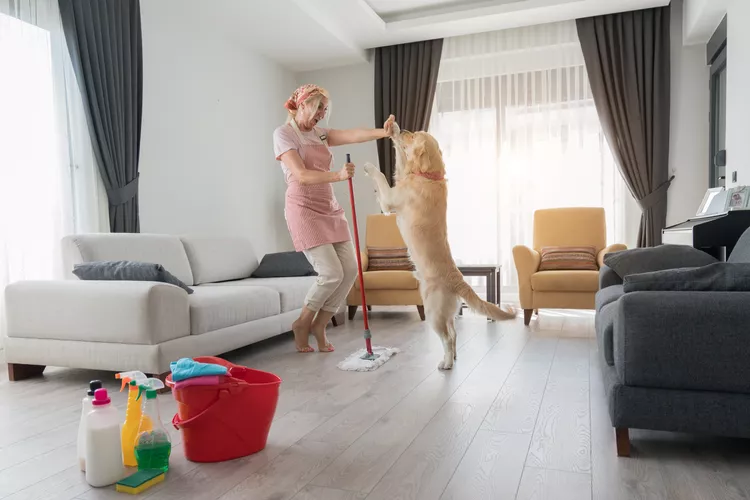How to Keep Spring Cleaning Safe for Your Pets

Spring is here! For many of us, that means it's time to clean, freshen up our homes, and (literally) dust off the winter blues. But when you have another furry resident in your household, it can be tricky to make sure your home stays safe when it gets a fresh wash.
What are the best practices for ensuring your pet won’t get sick or injured? We spoke to small animal veterinarian Dr. Sarah Wooten, DVM, for the tips you’ll need to get all your cleaning done in the safest way possible.
No Toxins
In general, if you have pets, there are certain ingredients that are toxic if ingested or inhaled. Wooten advises pet owners to avoid products that contain the following:
- ammonia
- chlorine
- bleach
- alcohol
- phenols
- formaldehyde
- quaternary ammonium
- phthalates
- hydrogen peroxide
In addition, essential oils can be toxic for cats, birds, and even dogs. Fabric softener sheets should also be stored away from pets as they can be toxic before they are used in the dryer.
When in doubt, also check the labels. Most cleaning products will have hazard warnings that say “danger,” “warning,” “caution,” or “use in a well-ventilated area.”
If you do end up using any of those products, remove your pet from the area while cleaning, and make sure the area dries completely. Ventilate the area well for several hours before returning the pet to the area to reduce the likelihood of toxicity or adverse effects, Wooten cautioned.
Find Pet-Friendly Cleaning Options
“While vacuuming isn’t a ‘product’, it is one of the most important things you can do to reduce accumulation of pet hair, dirt, and any external parasites that like to ride in on your pet, such as fleas!,” Wooten added.
Fleas of all life stages love to hide in carpets and under furniture cushions, so vacuuming at least weekly should be part of your routine (a more frequent routine may be required if your pet is shedding or tracking in dirt when they come inside).
Wooten also recommends robotic vacuums, lint rollers, dry mops, and sweeping with a broom.
“I also recommend having your carpets cleaned at least once a year or more often by a professional,” she said. In those cases, remove your pet from the house and follow the instructions above before you let them near the carpet.
Most bedding, clothing, blankets, or toys that your pet uses can also be used in the hot water cycle of a typical washer.
Have These Products on Hand
If your pet has an accident in the house, Dr. Wooten recommends always cleaning it up with an enzymatic cleanser.
“These are not only pet safe, but they also break down any chemicals the pet leaves behind in feces or urine that ‘mark’ the area, and that is important to help train the pet to not go in that area,” she said.
Another good non-toxic carpet spot cleaner is baking soda and white vinegar. If you cover the spot with baking soda and let it sit for seven minutes, Wooten said it will work wonders—just make sure you vacuum up the baking soda.
For hardwood floors, too, Dr. Wooten recommends making a solution that is equal parts white vinegar and water, putting it in a spray bottle, and spraying the spot (or pouring the solution on the spot). Afterward, blot the solution until dry and repeat until the stain is gone.
Solutions That Won’t Overwhelm Your Nose
Applying baking soda to mask any leftover odor from the boiling water solution is a great way to clean it up, says Dr. Wooten.
If you want a lemon fresh scent, she advises making an infusion with white vinegar and lemon peels (or orange peels).
“Just combine the two in a sealable jar you can store for a couple of weeks in a cool, dark cabinet or shelf, then strain out the peels. You’ll have a perfect, lemon-scented pet safe cleaning ingredient,” she said.
Keep Track of Your Pet’s Messes
Pets that live in an enclosure most of the time, such as birds, hamsters, and bunnies have most of their messes contained, but that space is likely to accumulate odor and debris more quickly, Dr. Wooten added. This means cages need to be cleaned more often, and pet owners will need to think about trying to keep food and water in one area of the cage and the spot for poop and urine in another. Some of these pets may drop food or bedding outside of the cage, so a liner under the cage that can catch additional debris will help keep things cleaner.
Meanwhile, a pet that roams around the house will have access to more places to possibly create messes, but it will be less concentrated, she said. “You will need to think about things like litter box training—I’m thinking bunnies and other small mammals—hair control, and protecting your stuff from them chewing on your furniture/baseboards/whatever else they can get their little teeth on,” she said.
In general, taking on a pet can be a huge responsibility for cleanliness, but with practice and mindfulness, you'll find a safe and easy routine that is right for you—and your pet.